Dynamics Underlying the Gaussian Distribution of the Classical Harmonic Oscillator in Zero-Point Radiation
Abstract
Stochastic electrodynamics (SED) predicts a Gaussian probability distribution for a classical harmonic oscillator in the vacuum field. This probability distribution is identical to that of the ground state quantum harmonic oscillator. Thus, the Heisenberg minimum uncertainty relation is recovered in SED. To understand the dynamics that give rise to the uncertainty relation and the Gaussian probability distribution, we perform a numerical simulation and follow the motion of the oscillator. The dynamical information obtained through the simulation provides insight to the connection between the classic double-peak probability distribution and the Gaussian probability distribution. A main objective for SED research is to establish to what extent the results of quantum mechanics can be obtained. The present simulation method can be applied to other physical systems, and it may assist in evaluating the validity range of SED.
1. Introduction
According to quantum electrodynamics, the vacuum is not a tranquil place. A background electromagnetic field, called the electromagnetic vacuum field, is always present, independent of any external electromagnetic source [1]. The first experimental evidence of the vacuum field dates back to 1947 when Lamb and his student Retherford found an unexpected shift in the hydrogen fine structure spectrum [2, 3]. The physical existence of the vacuum field has inspired an interesting modification to the classical mechanics, known as stochastic electrodynamics (SED) [4]. As a variation of classical electrodynamics, SED adds a background electromagnetic vacuum field to the classical mechanics. The vacuum field as formulated in SED has no adjustable parameters except that each field mode has a random initial phase and the field strength is set by the Planck constant, ℏ. With the aid of this background field, SED is able to reproduce a number of results that were originally thought to be pure quantum effects [1, 4–8].
Despite that the classical mechanics and SED are both theories that give trajectories of particles, the probability distributions of the harmonic oscillator in both theories are very different. In a study of the harmonic oscillator, Boyer showed that the moments 〈xn〉 of an SED harmonic oscillator are identical to those of the ground state quantum harmonic oscillator [9]. As a consequence, the Heisenberg minimum uncertainty relation is satisfied, and the probability distributions of an SED harmonic oscillator are a Gaussian, identical to that of the ground state quantum harmonic oscillator. While in classical mechanics it is most likely to find an oscillator at the two turning points of the trajectory, hence the double-peak probability distribution, the SED Gaussian probability distribution has the maximum in the center (see Figure 1). How do the dynamics differ in the two classical theories so that the probability distributions become so different?
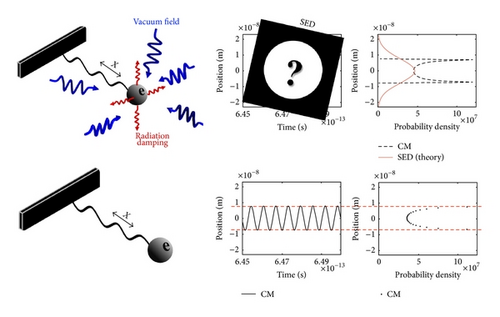
Although the analytical solution of an SED harmonic oscillator was given a long time ago, it is not straightforward to see the dynamical properties of a single particle from the complicated solution. Additionally, many results in SED such as probability distribution are obtained from (ensemble) phase averaging. Thus, they cannot be used for the interpretation of a single particle’s dynamical behavior in time (some may consider applying the central limit theorem and treat the positions in the time sequence as independent random variables. However, for an SED system this cannot work, because the correlation between the motion at two points in time persists beyond many cycles of oscillation) unless the system is proved to be ergodic. As an analytical proof of the ergodicity is very difficult, we take a numerical approach to study the particle’s dynamical behavior. Besides what is already known from the analytical solution, our numerical studies construct the probability distribution from a single particle’s trajectory. We investigate the relation between such a probability distribution and the particle’s dynamical behavior. Ultimately, we want to know the underlying mechanism that turns the classic double-peak distribution into the Gaussian distribution.
While most works in the field of SED are analytical, numerical studies are rare [10–12]. The advantage of numerical simulation is that it may be extended to other physical systems with relative ease and is flexible in testing different assumptions and approximations. For example, in most SED analyses the effect of the Lorentz force due to the vacuum field is often neglected as the first-order approximation [5]. However, when the field gradient is nonzero, the Lorentz force from the magnetic field can work with the electric field to give a nonzero drift to a charged particle, known as the ponderomotive force. Therefore, the Lorentz force of the vacuum field may play a significant role in SED. In fact, it is shown in the literature that the magnetic part of the vacuum field is responsible for the self-ionization of the atoms and the acquisition of an energy 1020 eV in a few nanoseconds by part of a free electron in vacuum [13, 14]. Using numerical simulation, one can easily examine SED beyond the first-order approximation (in this work we limit ourselves to physical parameters where we expect the Lorentz force effects to be minimal, as this work is compared to analytical results where this approximation is made), and the Lorentz force effects in SED can be investigated.
The major challenge for the numerical simulation is to properly account for the vacuum field modes. A representative sampling of the modes is thus the key for successful simulations. In this study, one of our goals is to use a simple physical system, namely, the simple harmonic oscillator, to benchmark our numerical method of vacuum mode selection so that it can be used to test the validity range of SED as discussed in the following.
Over the decades, SED has been criticized for several drawbacks [15]. Authors like Cavalleri argued that SED can neither explain electron slit-diffraction nor derive the nonlinear Schrödinger equation; moreover, SED implies broad radiation and absorption spectra for rarefied gases. In the case of the quartic anharmonic oscillator, Pesquera and Claverie showed that SED disagrees with quantum mechanics [16]. Additionally, the results claimed in [17–19] were shown to be wrong due to improper relativistic approximation [20]. While these theoretical analyses are documented in detail, it may be useful to use numerical simulation as an independent check in order to establish the validity range of SED, which is one of the objectives of our work.
Meanwhile, a modified theory called stochastic electrodynamics with spin (SEDS) was recently proposed [15]. As SEDS are an extension of SED with a model of electron spin motion, it is argued that the introduction of electron spin can eliminate several drawbacks of SED. Among all, it is claimed that SEDS allows the derivation of the complete and even the generalized Schrödinger equation [21–24]. Also, it is claimed that SEDS can explain electron slit-diffraction and the sharp spectral lines of the rarefied gases [25]. In view of the fact that SEDS is a modified theory from SED and may extend its validity range, it is probably important as a next step to apply numerical simulation to such a model as a “quasi-experiment” and test some of its claims. Models that include constraints can be incorporated in our numerical model with, for example, Lagrange multipliers.
The organization of this paper is the following. First, in Section 2 Boyer’s results on the SED harmonic oscillator are briefly reviewed. Based on these results, the probability distribution for the oscillator is derived. Second, in Section 3 details for simulating the vacuum field and the SED harmonic oscillator are documented. Third, in Section 4 the trajectory of the SED harmonic oscillator is solved numerically, and the constructed probability distribution is compared to the analytical probability distribution. Two sampling methods are used in constructing the probability distribution from the simulated trajectories. The first method is “sequential sampling,” which is suitable for studying the relation between the dynamics of the SED harmonic oscillator and its probability distribution. The second approach is “ensemble sampling,” which lends itself well to parallel computing and is convenient for statistical interpretations. Lastly, in Section 6 we discuss some potential applications of the numerical simulation in studying other quantum phenomena. Numerical studies have an advantage over the analytical solutions in that they can be adopted to a range of physical systems, and we hope that the current method of simulation may also assist in assessing SED’s validity range.
2. Theory of Stochastic Electrodynamics
2.1. Brief Review of Boyer’s Work
2.2. Probability Distribution
3. Methods of Numerical Simulation
3.1. Vacuum Field in Bounded Space

In summary, the vacuum field mode (k, λ) in (36) can be sampled by a set of four numbers (κi, ϑi, φi, χi), which are specified in (32), (33), (34), and (37). The only assumption used in determining these numbers is (35), which is equivalent to the sharp resonance condition (9) used in Boyer’s analysis.
3.2. Equation of Motion in Numerical Simulation
To summarize, (53) is the approximated equation of motion to be used in numerical simulation. The vacuum field Evac,x in (53) is given by (39). The specifications of the vacuum field modes (k, λ), polarizations εk,λ, and other relevant variables can be found in Section 3.1. To approximate (38) by (53), two conditions need to be used, namely, the dipole approximation (5) and the sharp resonance condition (9). The parameters q, m, and ω0 simulation should be chosen to satisfy these two conditions, as these two conditions are also used in Boyer’s analysis. Lastly, the integration time τint for the simulation is chosen to be within the range τtrans ≪ τint ≤ τrep, where τtran and τrep are given in (57) and (58), respectively.
4. Simulation Results
In Section 2, it was shown that the probability distribution for an SED harmonic oscillator is a Gaussian. In Section 3, we develop the methods for a numerical simulation to investigate the dynamics of the SED harmonic oscillator and how it gives rise to the Gaussian probability distribution. In this section, the results of the simulation are presented, and the relation between the trajectory and the probability distribution is discussed.
To construct the probability distribution from a particle’s trajectory, two sampling methods are used. The first method is sequential sampling and the second method is ensemble sampling. In sequential sampling the position or velocity is recorded in a time sequence from a single particle’s trajectory, while in ensemble sampling the same is recorded only at the end of the simulation from an ensemble of particle trajectories. The recorded positions or velocities are collected in histogram and then converted to a probability distribution for comparison to the analytical result (17). Whereas the sequential sampling illustrates the relationship between the buildup of probability distribution and the dynamics of particle trajectory, the ensemble sampling is convenient for statistical interpretation. In addition, the ensemble sampling is suitable for parallel computing, which can be used to improve the computation efficiency.
4.1. Particle Trajectory and the Probability Distribution
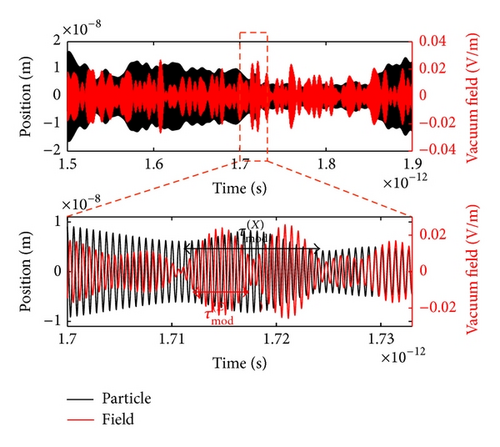
The sequential sampling of a simulated trajectory gives the probability distributions in Figure 4. While Boyer’s result is obtained through ensemble (phase) averaging, the Gaussian probability distribution shown here is constructed from a single trajectory and is identical to the probability distribution of a ground state quantum harmonic oscillator.
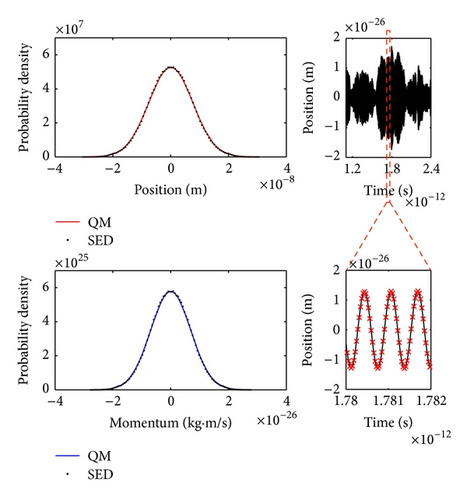
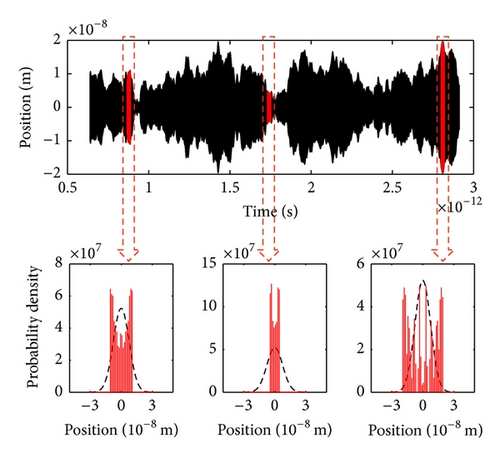

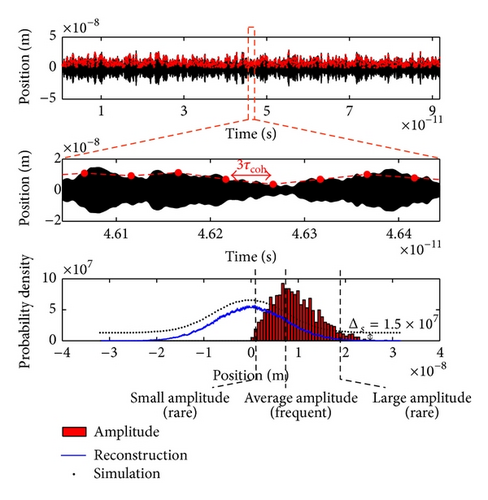
4.2. Phase Averaging and Ensemble Sampling
In many SED analyses [4–7, 9, 34], the procedure of random phase averaging is often used to obtain the statistical properties of the physical system. A proper comparison between numerical simulation and analysis should thus be based on ensemble sampling. In each realization of ensemble sampling, the particle is prepared with identical initial conditions, but the vacuum field differs in its initial random phase . The difference in the initial random phase corresponds to the different physical realizations in random phase averaging. At the end of the simulation, physical quantities such as position and momentum are recorded from an ensemble of trajectories.
The ensemble sampling of the simulation gives the probability distributions in Figure 8. The position and momentum distributions satisfy the Heisenberg minimum uncertainty as predicted by Boyer’s analysis. In addition, Boyer proposed a mechanism for the minimum uncertainty using an energy-balance argument. Namely, he calculated the energy gain from the vacuum field and the energy loss through radiation damping, and he found that the delicate balance results in the minimum uncertainty relation [4]. We confirm this balancing mechanism by turning off the radiation damping in the simulation and see that the minimum uncertainty relation no longer holds (see Figure 9).
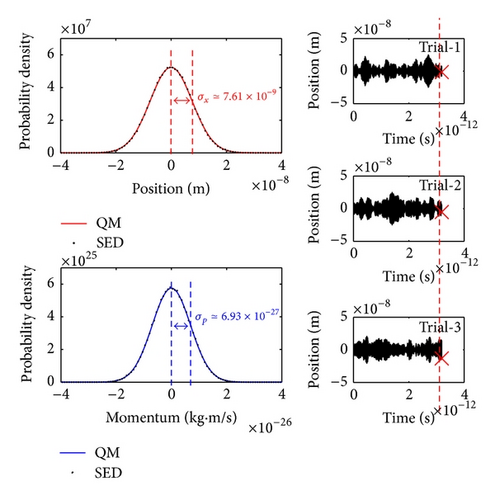
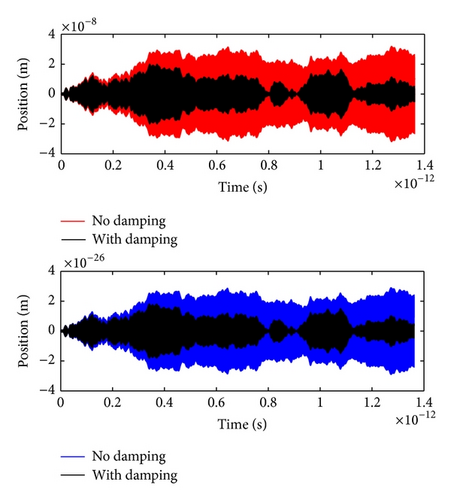
Unlike sequential sampling, ensemble sampling has the advantage that the recorded data are fully uncorrelated. As a result, the integration time does not need to be very long compared to the coherence time τcoh. However, since only one data point is recorded from each trajectory, a simulation with ensemble sampling actually takes longer time than with sequential sampling. For example, a typical simulation run with sequential sampling takes 2.3 hours to finish (for number of sampled frequencies Nω = 2 × 104), but with ensemble sampling it takes 61 hours (for number of particles Np = 2 × 105 and number of sampled frequencies Nω = 5 × 102). A remedy to this problem is to use parallel computing for the simulation. The parallelization scheme (the parallelization of the simulation program is developed and benchmarked with assistance from the University of Nebraska, Holland Computing Center. The program is written in Fortran and parallelized using message passing interface (MPI) [32, 35]. The compiler used in this work is the GNU Compiler Collection (GCC) gcc-4.4.1 and the MPI wrapper used is openmpi-1.4.3.) for our simulation with ensemble sampling is straightforward, since each trajectory is independent except for the random initial phases . To reduce the amount of interprocessor communication and computation overhead, each processor is assigned an equal amount of work. The parallelized program is benchmarked and shows an inverse relation between the computation time and the number of processors (see Figure 10). As the computation speedup is defined as Sp = T1/Tp, where T1 is the single processor computation time and Tp is the multiprocessor computation time, the inverse relation shown in Figure 10 indicates ideal performance of linear speedup. As an additional note, the parallelized code is advantageous for testing the numerical convergence of the simulation. In Figure 11, the convergence of the ensemble-averaged energy as a function of sampled frequency number is shown. As highlighted in the figure, only Nω = 5 × 102 sampled modes need to be used for the simulation to agree with the analytical result. The fact that Nω is low indicates that our method of vacuum mode selection is efficient.
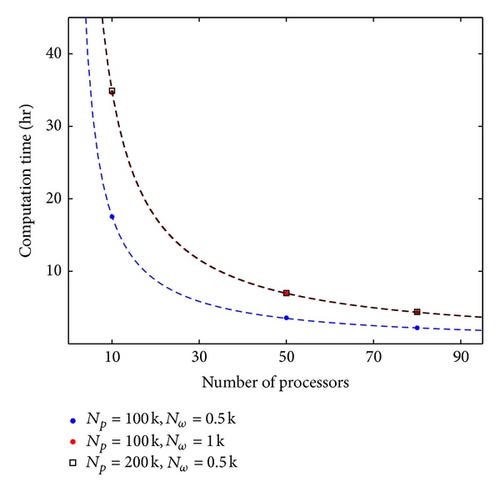
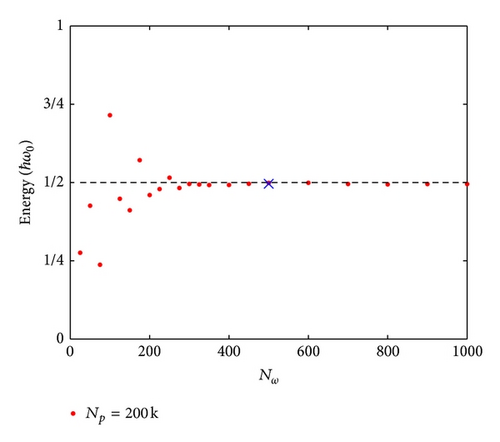
5. Conclusions
The analytical probability distribution of an SED harmonic oscillator is obtained in Section 2. The details of our numerical methods including vacuum mode selection are documented in Section 3. Agreement is found between the simulation and the analytical results, as both sequential sampling and ensemble sampling give the same probability distribution as the analytical result (see Figures 4 and 8). Numerical convergence is reached with a low number of sampled vacuum field mode (Nω = 5 × 102), which is an indication that our method of vacuum mode selection ((32), (33), (34), and (37)) is effective in achieving a representative sampling.
As the probability distribution constructed from a single trajectory is a Gaussian and satisfies the Heisenberg minimum uncertainty relation, we investigate the relation between the Gaussian probability distribution and the particle’s dynamical properties. As a result, the amplitude modulation of the SED harmonic oscillator at the time scale of τcoh is found to be the cause for the transitioning from the double-peak probability distribution to the Gaussian probability distribution (see Figures 5, 7, and 12).
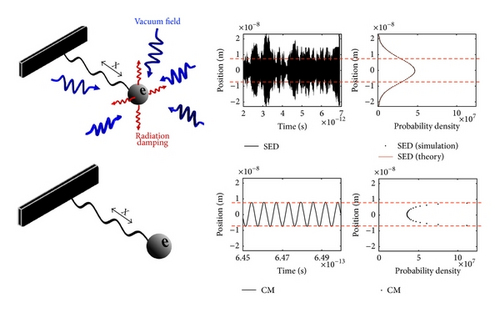
6. Discussions: Application of Simulation to Other Physical Systems
In quantum mechanics, the harmonic oscillator has excited, coherent, and squeezed states. A natural extension of our current work is to search for the SED correspondence of such states. Currently, we are investigating how a Gaussian pulse with different harmonics of ω0 will affect the SED harmonic oscillator. Can the SED harmonic oscillator support a discrete excitation spectrum, and if so, how does it compare with the prediction from quantum mechanics? Such a study is interesting in the broader view of Milonni’s comment that SED is unable to account for the discrete energy levels of interacting atoms [1] and also Boyer’s comment that at present the line spectra of atoms are still unexplained in SED [36].
The methods of our numerical simulation may be applicable to study other quantum systems that are related to the harmonic oscillator, such as a charged particle in a uniform magnetic field and the anharmonic oscillator [5, 34]. For the first example, classically, a particle in a uniform magnetic field performs cyclotron motion. Such a system can be viewed as a two-dimensional oscillator, having the natural frequency set by the Larmor frequency. On the other hand, a quantum mechanical calculation for the same system reveals Landau quantization. The quantum orbitals of cyclotron motion are discrete and degenerate. Such a system presents a challenge to SED. For the second example, a harmonic potential can be modified to include anharmonic terms of various strengths. Heisenberg considered such a system a critical test in the early development of quantum mechanics [37, 38]. We think that a study of the anharmonic oscillator is thus a natural extension of our current study and may serve as a test for SED.
Lastly, over the last decades there has been a sustained interest to explain the origin of electron spin and the mechanism behind the electron double-slit diffraction with SED [15, 39–41]. Several attempts were made to construct a dynamical model that accounts for electron spin. In 1982, de la Peña calculated the phase averaged mechanical angular momentum of a three-dimensional harmonic oscillator. The result deviates from the electron spin magnitude by a factor of 2 [39]. One year later, Sachidanandam derived the intrinsic spin one-half of a free electron in a uniform magnetic field [40]. Whereas Sachidanandam’s calculation is based on the phase averaged canonical angular momentum, his result is consistent with Boyer’s earlier work where Landau diamagnetism is derived via the phase averaged mechanical angular momentum of an electron in a uniform magnetic field [5]. Although these results are intriguing, the most important aspect of spin, the spin quantization, has not been shown. If passed through a Stern-Gerlach magnet, will the electrons in the SED description split into two groups of trajectories (electron Stern-Gerlach effect is an interesting but controversial topic in its own right. Whereas Bohr and Pauli asserted that an electron beam cannot be separated by spin based on the concept of classical trajectories [42], Batelaan et al. [43, 44] and Dehmelt argue that one can do so with certain Stern-Gerlach-like devices [45, 46])? At this point, the dynamics become delicate and rather complex. To further investigate such a model of spin, a numerical simulation may be helpful.
On the other hand, over the years claims have been made that SED can predict double-slit electron diffraction [4, 15, 41]. In order to explain the experimentally observed electron double-slit diffraction (see [47, 48] for a movie of the single electron buildup of a double-slit diffraction pattern) [49–51], different mechanisms motivated by SED were proposed [15, 41], but no concrete calculation has been given except for a detailed account of the slit-diffracted vacuum field [52]. In 1999, Kracklauer suggested that particles steered by the modulating waves of the SED vacuum field should display a diffraction pattern when passing through a slit, since the vacuum field itself is diffracted [41]. In recent years, another diffraction mechanism is proposed by Cavalleri et al. in relation to a postulated electron spin motion [15]. Despite these efforts, Boyer points out in a recent review article that at present there is still no concrete SED calculation on the double-slit diffraction [36]. Boyer suggests that as the correlation function of the vacuum field near the slits is modified by the slit boundary, the motion of the electron near the slits should be influenced as well. Can the scattering of the vacuum field be the physical mechanism behind the electron double-slit diffraction (see Figure 13)? As Heisenberg’s uncertainty relation is a central feature in all matter diffraction phenomena, any proposed mechanism for electron double-slit diffraction must be able to account for Heisenberg’s uncertainty relation. In the physical system of the harmonic oscillator, SED demonstrates a mechanism that gives rise to the Heisenberg minimum uncertainty. We hope that the current simulation method may help in providing a detailed investigation on the proposed SED mechanisms for the electron slit-diffraction.
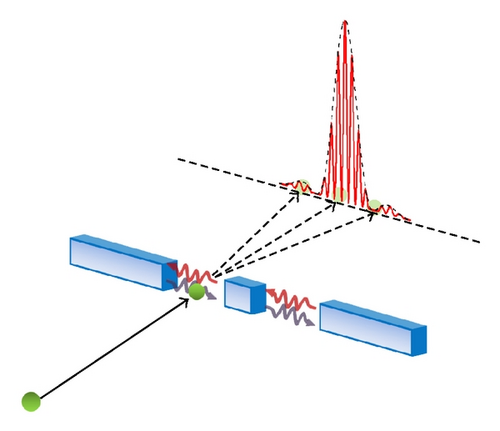
Acknowledgments
This work was completed utilizing the Holland Computing Center of the University of Nebraska. In particular, the authors thank Dr. Adam Caprez, Charles Nugent, Praga Angu, and Stephen Mkandawire for their work on parallelizing the SED simulation code. Huang thanks Dr. Bradley A. Shadwick, Roger Bach, and Dr. Steven R. Dunbar for stimulating discussions. This work is supported by NSF Grant no. 0969506.
Appendices
A. The Vacuum Field in Unbounded and Bounded Space
In “unbounded” space, the modes are continuous and the field is expressed in terms of an integral. In “bounded” space, the modes are discrete and the field is expressed in terms of a summation. In both cases, the expression for the field amplitude needs to be obtained (see Appendices A.1 and A.2). The integral expression helps comparison with analytical calculations in previous papers [4–7, 9], while the summation expression is what we use in our numerical work.
A.1. Unbounded Space
A.2. Bounded Space
B. Isotropic Polarization Vectors
C. Repetitive Time





